
Orbital Sciences Corporation Lockheed L-1011
|
(Download a higher resolution picture by clicking on any
picture below.) 
The Orbital Sciences Corporation Lockheed L-1011, N140SC Stargazer launches satelites into orbit on Pegasus-XL boosters. It carries Lockheed construction number 1067. It began its career with Air Canada, registered as C-FTNJ in March 1974.
 Lockheed L-1011, C-FTNJ at Los
Angeles, April 13, 1974, just one month after being delivered to
Air Canada.
Lockheed L-1011, C-FTNJ at Los
Angeles, April 13, 1974, just one month after being delivered to
Air Canada.
It was leased to Air Lanka for a couple of weeks in February 1982, during which it was registered as 4R-TNJ. Air Canada parked it at Marana, Arizona in November 1990. Orbital Sciences Corporation pulled it out of storage in May 1992, registered it as N140SC, and named it Stargazer.
A fairing was constructed underneath the fuselage to hold the Pegasus XL. The Lockheed L-1011 has a unusual double keel structure that the vertical fin of the Pegasus XL fits between. The fin goes in the space formerly occupied by the lower deck galley. The rest of the vehicle is carried entirely below the fuselage of the Stargazer.
Stargazer has launched four Pegasus boosters and 20 Pegasus XL boosters. Stargazer was used to launch a Pegasus booster for the first time on April 3, 1995.
Link to Encyclopedia Astronautica's Pegasus XL launch chronology.
 Stargazer was displayed at the
Vandenberg AFB Open House on April 9, 1995, just six days after
it first launched a Pegasus booster. The white trailer is used to
transport the Pegasus booster and to load it onto the Stargazer.
Stargazer was displayed at the
Vandenberg AFB Open House on April 9, 1995, just six days after
it first launched a Pegasus booster. The white trailer is used to
transport the Pegasus booster and to load it onto the Stargazer.
 Stargazer on the flightline at the
Dryden Flight Research Center at Edwards Air Force Base on July
29, 1997. Stargazer is particpating in Adaptive Performance
Optimization experiments for the Dryden Flight Research Center.
Stargazer on the flightline at the
Dryden Flight Research Center at Edwards Air Force Base on July
29, 1997. Stargazer is particpating in Adaptive Performance
Optimization experiments for the Dryden Flight Research Center.
Link to NASA Dryden's L-1011 Photo Gallery Contact Sheet.
Link to nasatech.com's page explaining the Adaptive Performance Opimization experiments.
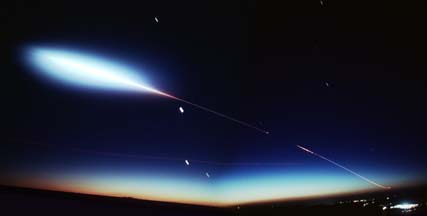 A Pegasus XL booster carrying the Wide-field Infra Red
Explorer (WIRE) spacecraft was launched from Stargazer off
the California coast at 6:56 P.M. on March 4, 1999. The booster
climbed out of the earth's shadow during the second stage engine
burn in this time exposure. It is framed by the planets Mercury,
Jupiter, Venus, and Saturn. The bright spot at the lower right is
the lights of the town of Buellton in the Santa Ynez Valley.
A Pegasus XL booster carrying the Wide-field Infra Red
Explorer (WIRE) spacecraft was launched from Stargazer off
the California coast at 6:56 P.M. on March 4, 1999. The booster
climbed out of the earth's shadow during the second stage engine
burn in this time exposure. It is framed by the planets Mercury,
Jupiter, Venus, and Saturn. The bright spot at the lower right is
the lights of the town of Buellton in the Santa Ynez Valley.
Link to the Infra-red Processing and Analysis WIRE home page.
The Orbital Sciences Corporation L-1011, Stargazer, carried the High Energy Solar Spectroscopic Imager (HESSI) spacecraft from Vandenberg Air Force Base, California to the Kennedy Space Center in Florida on Friday February 1.
 A small fleet of Orbital Sciences
Corporation and NASA vehicles are grouped alongside the Stargazer
as the crew prepares for take-off.
A small fleet of Orbital Sciences
Corporation and NASA vehicles are grouped alongside the Stargazer
as the crew prepares for take-off.
HESSI will study the X-ray and Gamma-ray spectra of solar flares. It has the ability to record the spectra from the different parts of each flare as it changes over time, creating movies that will help to reveal the nature of the forces that create and shape these titanic eruptions. It will also study high energy events outside the Solar System.
Link to the Goddard Space Flight Center's HESSI spacecraft home page.
Stargazer previously delivered the HESSI spacecraft to the Kennedy Space Center on June 2, 2001, the same day that the modified Pegasus booster carrying the Hyper-X supersonic combustion ramjet testbed went out of control. Stargazer returned to Vandenberg Air Force Base with the HESSI spacecraft last June21 so that Orbital Sciences Corporation could tend to the Pegasus-XL booster while the cause of the accident was determined.
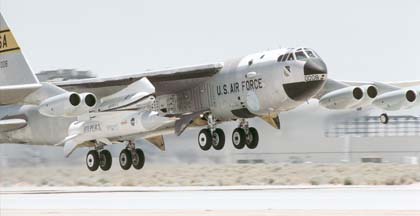 NASA's NB-52B, 52-0008 takes off from Runway 22
at Edwards Air Force Base to launch the Hyper-X mission on
June 2, 2001.
NASA's NB-52B, 52-0008 takes off from Runway 22
at Edwards Air Force Base to launch the Hyper-X mission on
June 2, 2001.
Link to NASA Dryden's Hyper-X fact sheet.
The HESSI spacecraft was re-mated to the Pegasus launch vehicle on December 20. The payload fairing was installed around HESSI on January 11.
The Flight Readiness Review was held at Kennedy Space Center on Monday, January 14. At the conclusion of the review, NASA and Orbital Sciences engineers decided to take an additional week to review the similarities of materials and components used on the Pegasus Orion solid rocket motor and the Graphite Epoxy Motor (GEM) of National Missile Defense BV-3 target vehicle that failed during launch late last year at Vandenberg.
The Pegasus was re-mated to the L-1011 on Tuesday, January 29.
 Orbital Sciences Corporation staff
prepare Stargazer for departure from Vandenberg AFB.
Orbital Sciences Corporation staff
prepare Stargazer for departure from Vandenberg AFB.
Link to the Orbital Sciences Corporation home page.
 The 3-stage Pegasus XL booster is
visible underneath the fuselage of the Lockheed Tri-Star.
The 3-stage Pegasus XL booster is
visible underneath the fuselage of the Lockheed Tri-Star.
Take off was delayed from 8:00 until 10:00. During that time, the sun moved to the other side of the runway from the position I had set up to shoot from. The sound of the back up warning from the runway grooving machine a mile and a half away could be heard through the quiet morning air.
 While we waited for Stargazer to
take off, a flock of deer wandered onto the short grass next to
the runway and began foraging. My escorts yelled across the
runway to chase them out of harm's way.
While we waited for Stargazer to
take off, a flock of deer wandered onto the short grass next to
the runway and began foraging. My escorts yelled across the
runway to chase them out of harm's way.
 Once Stargazer's pilots had
received their take-off clearance, the Tri-Star rolled onto the
runway and immediately began accelerating toward us.
Once Stargazer's pilots had
received their take-off clearance, the Tri-Star rolled onto the
runway and immediately began accelerating toward us.
 The nose gear lifts off the runway
as Stargazer accelerates.
The nose gear lifts off the runway
as Stargazer accelerates.
 Stargazer takes off with the HESSI
spacecraft.
Stargazer takes off with the HESSI
spacecraft.
 The gantry of Space Lanch Complex 2
is visible in the distance. A Delta-II carrying a constellation
of Iridium satellites is scheduled for launch from SLC-2 at 10:00
A.M. this coming Friday morning.
The gantry of Space Lanch Complex 2
is visible in the distance. A Delta-II carrying a constellation
of Iridium satellites is scheduled for launch from SLC-2 at 10:00
A.M. this coming Friday morning.
The HESSI mission was launched at 12:58 P.M. EST on Tuesday, February 5.
 Stargazer carries the HESSI
spacecraft and its Pegasus booster before launch. Frame from NASA-TV feed.
Stargazer carries the HESSI
spacecraft and its Pegasus booster before launch. Frame from NASA-TV feed.
 Frame from NASA-TV feed.
Frame from NASA-TV feed.
Stargazer dropped the Pegasus XL booster at an altitude of 39,000 feet at a location approximately 100 miles east-southeast from Cape Canaveral Air Force Station, Florida. Spacecraft separation from the Pegasus XL booster occurred approximately 9 1/2 minutes after launch. HESSI was placed in 370 mile-high (600 kilometer) orbit.
 The Canadian Space Agency's SCISAT-1 (Scientific Satellite Atmospheric
Chemistry Experiment) was launched from Stargazer at 7:09:33 P.M. on August 12.
The launch trail appeared through the gap below the top layer of
clouds right at 7:10.
The Canadian Space Agency's SCISAT-1 (Scientific Satellite Atmospheric
Chemistry Experiment) was launched from Stargazer at 7:09:33 P.M. on August 12.
The launch trail appeared through the gap below the top layer of
clouds right at 7:10.
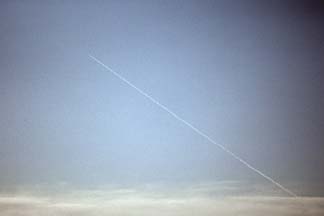 The rocket passed directly in front of the sun.
The upper stages left almost no exhaust trail. Just the flame of
the rocket was visible, ascending toward the southern sky.
The rocket passed directly in front of the sun.
The upper stages left almost no exhaust trail. Just the flame of
the rocket was visible, ascending toward the southern sky.
NASA's Demonstration of Autonomous Rendezvous Technology satellite was launched on an Orbital Sciences' Pegasus-XL booster at 10:27 A.M. PDT this morning. The Pegasus-XL booster was dropped from Orbital Sciences' L-1011 Stargazer N140SC, which took off from Vandenberg Air Force Base.
 Orbital Sciences' L-1011 Stargazer, N140SC returns to land on Runway 30 at Vandenberg AFB following the launch of the DART mission.
Orbital Sciences' L-1011 Stargazer, N140SC returns to land on Runway 30 at Vandenberg AFB following the launch of the DART mission.
Three Space Technology 5 satellites were placed in orbit by an Orbital Sciences Pegasus-XL booster launched from Orbital's Lockheed L-1011, N140SC Stargazer at 6:03 A.M. PST on March 22, 2006.
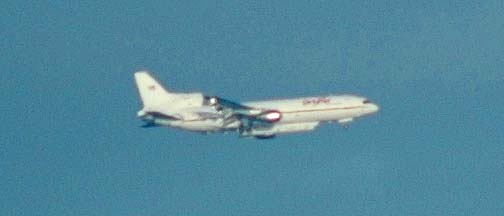 The first attempt to launch the Space Technology 5 satellites was aborted when a pin failed to retract from a control fin on the Pegasus-XL booster shortly before launch on March 15. Stargazer is seen here returning to Runway 12 at Vandenberg Air Force Base with the Pegasus-XL booster. The offending pin was replaced before the second launch attempt.
The first attempt to launch the Space Technology 5 satellites was aborted when a pin failed to retract from a control fin on the Pegasus-XL booster shortly before launch on March 15. Stargazer is seen here returning to Runway 12 at Vandenberg Air Force Base with the Pegasus-XL booster. The offending pin was replaced before the second launch attempt.
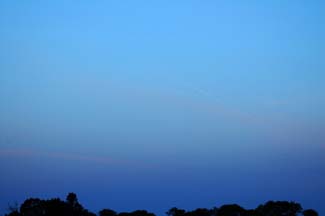 The second launch attempt came off without a hitch at sunrise. The contrail from the ascending Pegasus-XL booster is barely visible.
The second launch attempt came off without a hitch at sunrise. The contrail from the ascending Pegasus-XL booster is barely visible.
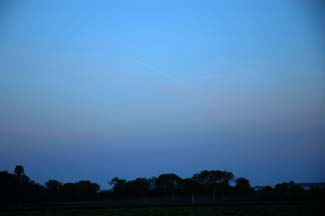 The contrail faded away in just a minute.
The contrail faded away in just a minute.
 This time Stargazer flew a right hand pattern that put it in front of the sun from where I was taking pictures..
This time Stargazer flew a right hand pattern that put it in front of the sun from where I was taking pictures..
The Aeronomy of Ice in the Mesosphere (AIM) mission was launched into orbit by an Orbital Sciences Pegasus-XL booster at 1:26 PM PDT on Wednesday, April 25, 2007. The rocket was carried to the launch position off the Pacific coast near Monterey by Orbital Sciences Lockheed L-1011 N140SC Stargazer, which staged out of Vandenberg Air Force Base.
Orbital Sciences Lockheed L-1011 N140SC Stargazer took off with the Pegasus-XL/AIM at 12:27 PM PDT. The crew of Stargazer initiated the drop of the booster at 1:26 PM PDT. The four-stage rocket successfully boosted the AIM satellite into orbit 350 miles above the Earth.
 Stargazer passed overhead southbound about 20 minutes after the launch of the Pegasus-XL.
Stargazer passed overhead southbound about 20 minutes after the launch of the Pegasus-XL.
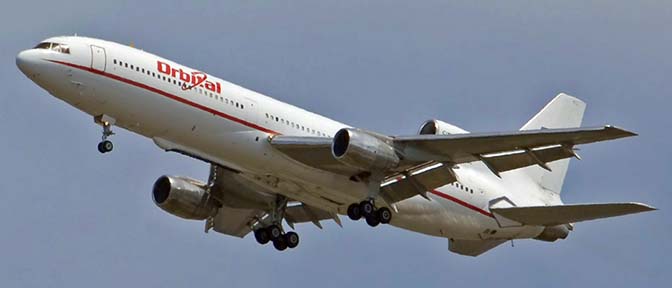 Stargazer returned from the successful launch of the AIM mission just after 2:00 PM.
Stargazer returned from the successful launch of the AIM mission just after 2:00 PM.
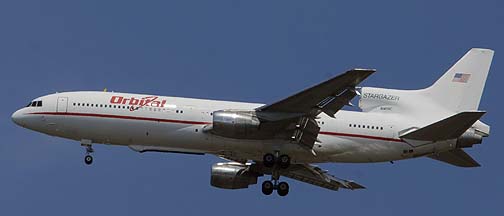 Orbital Sciences Lockheed L-1011 N140SC Stargazer
Orbital Sciences Lockheed L-1011 N140SC Stargazer
 Orbital Sciences Lockheed L-1011 N140SC Stargazer
Orbital Sciences Lockheed L-1011 N140SC Stargazer
Initial missions of the Orbital Sciences' Pegasus satelite booster were lanched from NASA's NB-52B. The NB-52B became the world's first manned, winged, return to launch site satellite launcher when it launched the Orbital Sciences' Pegasus booster on April 5, 1990.
 The NB-52B was displayed with
Pegasus s/n 002 at the October 6, 1990 Edwards Air Force Base
Open House. Pegasus s/n 002 was launched with seven 48-pound
Microsats on July 17, 1991. A failure during the first stage
separation resulted in the satellites failing to achive the
proper orbits.
The NB-52B was displayed with
Pegasus s/n 002 at the October 6, 1990 Edwards Air Force Base
Open House. Pegasus s/n 002 was launched with seven 48-pound
Microsats on July 17, 1991. A failure during the first stage
separation resulted in the satellites failing to achive the
proper orbits.
The NB-52B launched satellites on Pegasus boosters on six occasions. The last satellite launch from the NB-52B took place on August 3, 1994.
Link to NASA Dryden's NB-52B Mothership Photo Gallery Contact Sheet.
Link to NASA Dryden's Pegasus Photo Gallery Contact Sheet.
Link to Encyclopedia Astronautica's Pegasus launch chronology.
Link to the Aeronomy of Ice in the Mesosphere mission web site.Link to Encyclopedia Astronautica's Pegasus XL launch chronology.
Link to NASA Dryden's L-1011 Photo Gallery Contact Sheet.
Link to the Orbital Sciences Corporation home page.
The home page of the
30th Space Wing
For national and international space coverage visit SPACE.com
Brian Webb's Rawhide Space Page provides launch schedule and ham radio information.
I am always interested in more information about these launches. Send a message to Brian .